Beehive (New Zealand)
The Beehive is the common name for the Executive Wing of New Zealand Parliament Buildings, located at the corner of Molesworth Street and Lambton Quay, Wellington. It is so-called because its shape is reminiscent of that of a traditional woven form of beehive known as a "skep". It is registered as a Category I heritage building by Heritage New Zealand.
| Beehive | |
|---|---|
 Bowen House (left), the Beehive (centre) and Parliament (right). A very similar view of the latter two buildings features on New Zealand's $20 banknote. | |
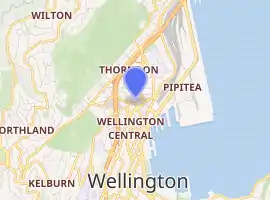
| |
| Alternative names | Executive Wing of the New Zealand Parliament Buildings |
| General information | |
| Address | Corner of Molesworth Street and Lambton Quay, Wellington |
| Coordinates | 41.2784°S 174.7767°E |
| Construction started | 1969 |
| Completed | 1981[1] |
| Inaugurated | May 1977 |
| Renovated |
|
| Owner | Government of New Zealand |
| Height | 72 metres (236 ft) |
| Technical details | |
| Floor count | 10 |
| Design and construction | |
| Architect | Sir Basil Spence |
| Structural engineer | Ministry of Works |
| Renovating team | |
| Architect | Warren and Mahoney |
| Website | |
| official website | |
| Designated | 24 July 2015 |
| Reference no. | 9629 |
Construction began in 1969 and was completed in 1981. Since 1979 the building has housed the offices of the prime minister and other ministers. Thus, the name "Beehive" is closely linked with the New Zealand Government.[2] It is often used as a metonym for the New Zealand leadership at large.[3]
History
In the 1960s the government proposed an extension of Parliament House, which had only been partly built in 1922. Prime Minister Keith Holyoake had wanted to complete the original plan, but the government architect persuaded him to approve a modern building which would house parliamentary offices.[4] In 1964, Scottish architect Sir Basil Spence provided the original conceptual design of a round building rising in steps. The detailed architectural design was undertaken by the New Zealand government architect Fergus Sheppard, and structural design of the building was undertaken by the Ministry of Works.[5] W. M. Angus constructed the first stage, beginning in 1969 – the podium, underground car park and basement for a national civil defence centre. Gibson O'Connor constructed the ten floors of the remainder of the building.[6]
.jpg.webp)
Bellamy's catering facilities moved into the building in the summer of 1975–76 and Elizabeth II, Queen of New Zealand, unveiled a plaque in the reception hall in February 1977. The Prime Minister, Robert Muldoon, formally opened the building in May 1977. The government moved into the upper floors in 1979. The annex facing Museum Street was completed in 1981.[6]
In the late 1990s there was consideration of moving the Beehive behind Parliament House, and finishing Parliament House according to the 1911 original plans. The plan was scuttled due to public outcry at the cost.[7] Renovations were carried out and the interior was modernised between 1998 and 2006 to plans by Christchurch architecture firm Warren and Mahoney. In 2013 and 2014, the roof was repaired and windows replaced.[5]
In July 2015, Heritage New Zealand declared the Beehive "of outstanding heritage significance for its central role in the governance of New Zealand". Blyss Wagstaff of Heritage New Zealand called it "one of the most recognisable buildings in the country". Heritage New Zealand assigned the highest rating for a historic place, Category I, to the building.[8] The original application for the heritage designation was made by Lockwood Smith, a former Speaker of the House of Representatives. The heritage registration with the list number 9629 became effective on 24 July 2015. The tunnel to Bowen House is specifically excluded from the heritage registration.[9][5]
Facts and figures
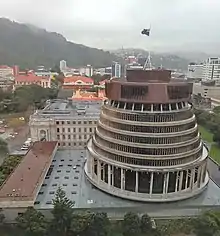
The building is ten storeys (72 metres (236 ft)) high and has four floors below ground.[10] The entrance foyer's core is decorated with marble floors, stainless steel mesh wall panels, and a translucent glass ceiling.[11]
The Beehive's brown roof is made from 20 tonnes of hand-welted and seamed copper. It has developed a naturally weathered appearance. A tunnel runs under Bowen Street from The Beehive to parliamentary offices in Bowen House.[5] The Beehive is extensively decorated with New Zealand art. On the inner wall of the Banquet Hall is a 42-metre-long 4.8-metre-high mural by John Drawbridge portraying the atmosphere and sky of New Zealand.[12]
The Beehive's circular footprint (see rotunda) is generally considered an elegant and distinctive design feature. However it is also quite impractical, as many of its rooms are wedge-shaped, curved or asymmetrical.[13] An extension has been built out the front to allow for a new security entrance. A new, bomb-proof mail delivery room has already been built at the rear of the building.[10]
The Beehive has, since 1992, featured as part of the design of the New Zealand twenty-dollar note.[14] A survey commissioned by the Reserve Bank of New Zealand found that the Beehive is "a New Zealand icon and as such is readily recognisable".[15]
Offices and facilities
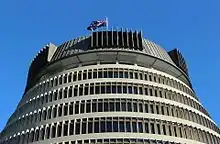
The top floor is occupied by the Cabinet room, with the prime minister's offices directly beneath on the ninth floor (and part of the eighth).[5] The upper portion of the Beehive also contains the offices of other ministers; senior ministers are situated at proximity to the prime minister's office according to their ranking in Cabinet. The seniority of a minister is reflected in how far up the building they are.[16][5] Some ministers, especially junior ministers, are instead based in Bowen House.[16]
Other facilities within the building include function rooms and a banqueting hall on the first floor of the Beehive, which is the largest function room in the parliamentary complex. The parliamentary catering facilities of Bellamy’s include a bar known as Pickwicks or 3.2 (due to its position in the building on the third floor and second corridor), Copperfield's café, and the Member's and Member's and Guests restaurants. The building also houses, in its basement, the country's National Crisis Management Centre.[9] The Beehive contains a theatrette, commonly used for government press conferences. Other facilities include a gym and a swimming pool. The parliament building is used by members of Parliament who hold meetings or are discussing bills or new laws.
Tours
The New Zealand Parliament's Visitor Centre, open most days from 9 am to 5 pm, is located on the ground floor of the Beehive.[17] Free guided tours lasting up to one hour are available, as are educational visits for students.
Tours were suspended in 2020 to limit the spread of COVID-19. The public gallery and select committee meetings remained open to the public, subject to review.[18]
Photo gallery
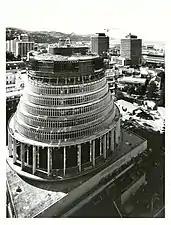 The Beehive under construction in 1978
The Beehive under construction in 1978 The Beehive and Parliament House in 1979
The Beehive and Parliament House in 1979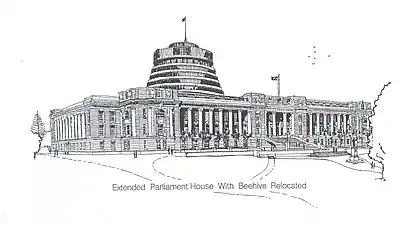 Illustration of proposal to move the Beehive behind Parliament House in 1997
Illustration of proposal to move the Beehive behind Parliament House in 1997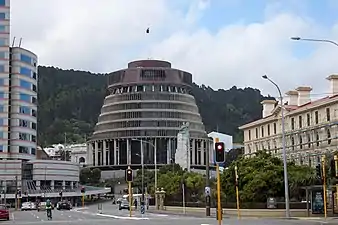 Beehive viewed from the south, with Bowen House to the left and Old Government Buildings, right
Beehive viewed from the south, with Bowen House to the left and Old Government Buildings, right
References
- The Beehive, Parliament Building and the Parliamentary Library Tiki Touring. Retrieved 25 January 2010.
- "Latest News from the Beehive". Beehive.govt.nz. New Zealand Government. Retrieved 19 August 2019.
Beehive.govt.nz is the best place to find Government initiatives, policies and Ministerial information.
- "the definition of beehive". Dictionary.com. Archived from the original on 6 April 2017. Retrieved 1 May 2017.
- "The Beehive". Te Ara: The Encyclopedia of New Zealand. Retrieved 25 March 2019.
- "Executive Wing (the Beehive)". Register of Historic Places. Heritage New Zealand. Retrieved 19 July 2015.
- Martin, John E. (28 March 2012). "History of Parliament's buildings and grounds". New Zealand Parliament. Retrieved 19 July 2015.
- Small, Vernon (12 September 2016). "Parliament poised for major building revamp, including plan for new office block". Stuff.co.nz. Retrieved 5 August 2020.
- "Executive Wing (the Beehive)". Heritage New Zealand. Retrieved 10 July 2017.
- Harris, Catherine (11 July 2015). "Beehive declared historic place". The Press. p. A10.
- Rodgers, Kerry (1 July 2011). "The contentious Beehive - Building Today Magazine". Building Today. Retrieved 10 July 2017.
- "The Beehive – Executive Wing". New Zealand Parliament. 31 October 2006. Archived from the original on 10 February 2013. Retrieved 25 January 2010.
- "John Drawbridge". The Arts Foundation. 26 September 2015. Retrieved 10 July 2017.
- "Beehive". Wellington City Heritage. Retrieved 10 July 2017.
- "$20 - Reserve Bank of New Zealand". www.rbnz.govt.nz. Retrieved 15 October 2020.
- "RBNZ Bank Notes Survey 2010 Consumer" (PDF). rbnz.govt.nz. Reserve Bank of New Zealand. Retrieved 22 June 2017.
- "Anatomy of a minister's office: What happens in the Beehive?". Radio New Zealand. 23 August 2018. Retrieved 6 April 2019.
- "Visitor Centre". New Zealand Parliament. Retrieved 24 June 2017.
- "Coronavirus: Public tours and school visits to Parliament cancelled amid COVID-19 concern". Newshub. Retrieved 15 October 2020.
External links
| Wikimedia Commons has media related to Beehive, Wellington. |
- The Beehive – New Zealand Parliament website
- History of Parliament Buildings – NZHistory